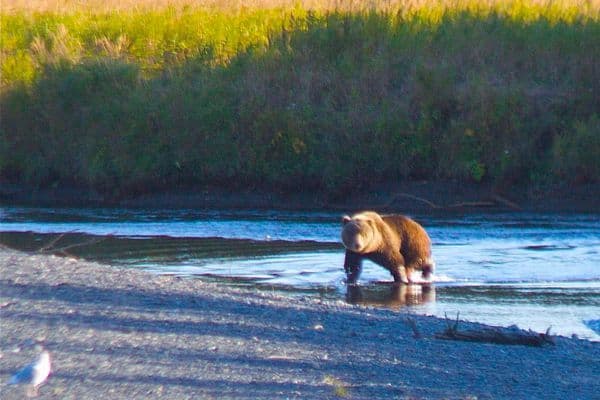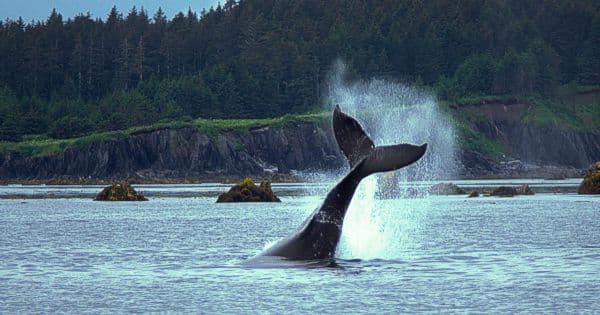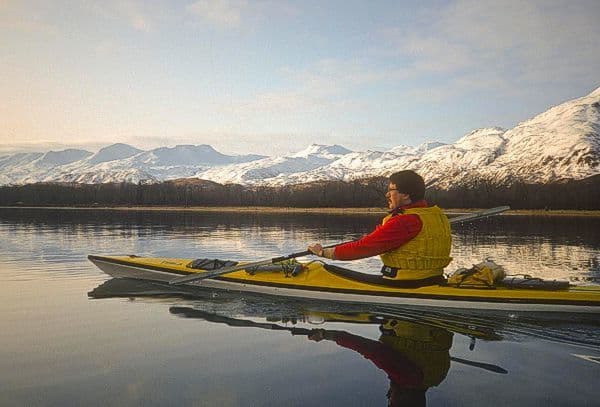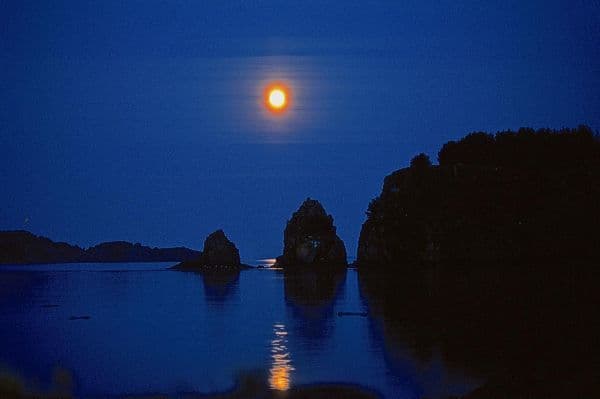Magical Moments: Kayaking Alaska
I learned to sea kayak in Alaska, in the waters of the Pacific Ocean surrounding Kodiak Island. From glass smooth surfaces that mimicked a tranquil mountain lake to ragged-peaked and wind-whipped waves of an angry sea tempest, I experienced many magical, exhilarating moments from the cockpit.
If I had to categorize those experiences, I’d put them into three broad categories:
Wildlife, weather and wonderment! No doubt kayak adventure stories may be prone to the same exponential growth in exaggeration as do tall fishing tales. Yet for a devoted kayaker, novice or seasoned, sharing personal experiences weaves together both the imagination of the teller and the listener to create an exciting, colorful story with each new rendition.
WILDLIFE:
I’ve felt the bump of a young sea lion against the bottom of my boat and had a huge, barrel-mouthed bull explode out of the water inches from a stringer of fish hanging over the side of my kayak. However, no Kodiak wildlife story is valid without at least a reference to its gigantic coastal brown bears. As a kayaker, I’ve only had two close encounters with the mighty and magnificent bruins. Going ashore while kayaking in bear country is not without a major dose of trepidation - and at least tossing a token amount of caution to the wind.
Kaflia’s inner bay looks and feels more like a mountain lake than a pocket of the North Pacific along the shores of Shelikof Straits west of Kodiak Island. It’s part of the Katmai Peninsula, and maybe 50 air miles south of the internationally famous bear viewing McNeal River. Steep, densely lush, stream-flowing valleys provide unlimited cover for the hundreds of bears living there.
I had beached my kayak about 20 yards from the mouth of a shallow stream that flowed out from an upper set of lakes a couple of hundred yards farther up the narrow valley that were popular destinations for fly-in bear viewing parties. It was August so stream flow was minimal; dorsal fins of returning salmon cut the surface as they struggled upstream. Walking along a well-worn trail (NOT made by hikers I might add) along the river bank, and stepping over several fresh piles of bear scat as I headed up to the first upper lake, I began talking loudly and rustling branches every step of the way.
Glassing the slopes for bears and seeing none, I quickly returned back downstream, continuing my one-sided conversation with an unseen “Mr. Bear” that I just sensed had to be within earshot. I paused midstream at the mouth, the shallow flow barely washing up over my toes, turned to look back up the valley one last time, and then stepped lively along the gravelly shore to my kayak.
As I reached to retrieve my spray skirt, I heard a sharp CLACK, like the sound a bowling ball makes when it hits another at the end of the ball return - or when a boulder is dislodged in a stream and rolls against another! I turned to see a young bear standing in the same exact spot I had been in just 30 seconds earlier. He had to have been in the bushes a few yards of me all the while!

I kept one eye on the big fur ball and quickly and quietly pushed off from shore. I spent the next few minutes bobbing in the slight swell as I watched him swipe at the salmon swishing past his paws. A magical encounter and a reminder as to who was at home and who was the paddling guest.
It was during this same trip that I had a yet another most incredible bear experience - this time it was the sheer number of encounters, without much of a threat, that was so awesome.
I was guiding my bear viewing by kayak trip; manning the rear cockpit in a double while my client fired away roll upon roll of film from the front. “You tell me what shots you want and I’ll get us into position” I assured him as we maneuvered across the shallow bay at low tide.
As we approached the upper limits of water, we could see bears scattered along the shoreline, a couple of dozen were working the beach for clams or lying alongside narrow rivulets of fresh water feeding into the bay - and serving as limited avenues for salmon staging themselves for the surge upstream as the tide changed back.
Ahead of us, on a grassy berm just up from the beach, were three cubs who had settled into the cushy bed of greenery, to watch the strange pod floating just off shore. Nearby a huge sow lounged in the gravel alongside a narrow stream of outflowing fresh water, snatching up the occasional salmon unlucky enough to swim within the effortless reach of her massive claws. Other bears scooped gigantic paws of sand away seeking burrowed clams while still others ambled lazily along the beach. We counted over thirty bruins along that hundred yard stretch of Katmai beach. It was the largest concentration of bears I had ever witnessed.
My client lowered his cannon-barreled telephoto lens to see just how close to dry land we had drifted. “Bears won’t come out this far from shore will they?” he asked. “Naw,” I said with a ‘trust me, I’m the guide’ air. I looked down at the sparkling clear water, now only about 15” deep, and saw that the entire sandy bottom, for as far as I could see in all directions, was an overlapping mosaic of fresh, frying-pan-sized paw prints. My hurried and determined back paddle was particularly effective that day.
WHALES
Anyone who’s spent time on waters shared by whales quickly learns that it’s best to let them come to you rather than trying to chase them down. Over the years I have enjoyed sightings of a few orcas, scores of humpbacks, a huge fin whale and even a Minke, all from the cockpit of my kayak.
Humpbacks, very common in Alaska’s waters, frequently feed very close to the cliffs near the city of Kodiak. It’s a wonderful place to watch a whale breach while you’re bobbing in a kayak a hundred yards away or less - indescribably breathtaking.

While feeding, whales tend to surface in a somewhat predictable pattern: watch where they rise, count as they go back down, learn the rhythm as they repeat their routine.
So it was one afternoon as I paddled leisurely behind an adult humpback cruising along about a quarter of a mile off shore. I was able to roughly anticipate each surfacing, camera at the ready. The casualness of this shared encounter got the better of me as I began to approach closer and closer to where I anticipated his resurface.
As he dropped out of sight and failed to come back up at the designated count, I anticipated that perhaps he was going to resurface one last time before doing the stand-up tail waving dive for the deep. I hurried along a likely course for about one hundred yards and stopped. He could come up anywhere - or not at all.
Suddenly I heard a fizzing sound as millions of tine bubbles percolated to the surface, like Alka-Seltzer in a glass of water. I was dead center in a huge, circular, effervescing patch at least fifty feet in diameter around my kayak. Anticipating an unsettling capsize, I quickly checked my spray skirt, tugged at the zipper on my PFD and curled my fingers firmly around my paddle shaft and surged backwards hoping to get clear of the column before it consumed me.
Just as my bow slid past the outer ring of ever-expanding bubbles, the ocean at the center of the circle bellowed upward, the rising dome of water parting to reveal the glistening hump on the back of a mountainous whale. It came straight up and stopped effortlessly like a trident submarine rising from the depths.
Its dark, dish-plate eye seemed to stare me down for a second before it slid back down into the bay and disappeared.
BIRDS
Bird watching from a kayak is one of the most satisfying aspects of the sport. On Kodiak, a typical sighting count from the cockpit on any given day was well into at least 30+ species. It was, however, the puffins, the sea-clowns or sea parrots, that probably create the most thrills for birders. Whether darting out from their cliff top nests or streaking across the water inches above the surface with short, frantic wing beats, they were always a treat to watch.
One evening, a buddy and I were enjoying a twilight paddle just as the tide was ebbing. We paddled a familiar route that gave us safe haven while traveling between the islands just beyond downtown Kodiak. As we turned to take a short cut back through the float plane basin in the waning daylight, I noticed a distinct V-shaped wake in the darkened surface of the water shadowed by the trees along the shore.
My first impression was that it was bulb of a bull kelp being dragged by the tidal current. Then it changed directions! Whatever the dark mass was, it was swimming a course that would take it directly across - or into - my bow. I eased up on the paddle and let the boat glide forward.
As the shadows thickened and the world around us darkened, I heard a thump near the tip of my bow, followed by a softer progression of sounds approaching up the deck towards my cockpit. I slowly raised my hand and fumbled for the switch on my headlamp.
The beam danced around the open water beyond before I settled it down along the line of my deck. The small spotlight fell upon a black feathery mass with a dull whitish-orange beak and tiny webbed feet. A young horned puffin stood on the peak of my foredeck only a foot beyond my cockpit.
As I sat motionless in delightful awe, it cocked its head left to right and back again. Then it seemed to shrug its shoulders as it turned sideways and literally skied down the sloping deck on its webbed feet and plopped back into the water. Others have had seal pups and babv otters crawl up onto their kayaks, but that one curious puffin fledgling will be hard to beat!
WEATHER
Kodiak has a Pacific Ocean maritime environment that is directly influenced by the Japanese Current. That climate enables kayakers to oftentimes paddle every month out of the year - on particularly pleasurable mid winter days when bays are calm, the air is +40F and the mountains rising high above the sparkling blue water are covered in blankets of pure white snow.

The Pacific, by name and nature, is the “peaceful” ocean - but with an unforgiving temper. It’s a Jeckyll & Hyde expanse of water. I’ve paddled her through both! Sometimes her waters are so smooth that the horizon disappears as sea diffuses into sky. At both extremes, there is something mesmerizing about her many personalities.
One summer afternoon, on a promisingly calm and sunny day, a darkening vail of rain appeared at the outer edge of the bay in which we were paddling. It was one of those isolated clouds that dumps its burden of moisture within its shadows when there’s a bright, sunny-bright seascape all around.
As I looked at the shower through binoculars I noticed something peculiar. The edge of the rain was falling absolutely vertical and in a line as straight and smooth as a stage curtain. You could see the distinct, defined edge of rain etching a line along the surface.
I drew hard on my paddle and hurried up to its outer edge. Indeed, there was a defined, vertical wall of water, a curtain of drops like water falling from the lineal straight edge of a fountain. I glided up to within arm’s reach of the rain and coasted to a stop with my kayak parallel to the face of the “wall”.
Reaching out with my arm I passed my hand into the curtain of rain and felt it’s gentle, tickling wetness against my skin. It was an incredibly magical moment to not only see this phenomenon but to actually touch it as well. It’s one of the most lasting and vivid memories of rain I have.
It was just a year later while coming back from a day-long paddle around the outer islands that I experienced the dark side of this same ocean.
The outer waters were a smooth, gentle rolling swell as I passed along the islands about five miles off shore. The trip back would be a long crossing to a mid island and then a shorter one back in through islands, rocks and channels to the beach near my house where I had started my paddle that morning. Twelve miles into it and just two more to go, I was a bit tired and eager to set foot on land again.
Just as I pushed off from the outermost tip of the far island and crossed into the wide channel, the sea and winds went from dead calm to an annoying breeze and roughness within about fifteen minutes. As I pushed on towards the mid island, it got even worse.
By the time I rounded the middle island the seas were stacking to three or four feet with horsetails of angry white spray and foam ripping off nearly every wave peak. I had two choices: return to the mid island and wait out the impending storm for perhaps a few days; or focus on a steadfast and admittedly exhilarating and wet bucking-bronco ride back to the sanctuary of the innermost islands and near-town channel. I readjusted my PFD, sprayskirt and hooded spray jacket and braced myself into my cockpit and paddled on.
My plan was to use the wind to ferry drift/paddle from channel buoy to buoy until I did the three-quarter mile crossing into the protection from the winds. Half way to the first buoy and my progress was slow but determined and I felt confident. As I raised my hood to get a sight bearing on the next buoy I heard a faint roar above me. I cranked my head sideways as much as I dared and saw the swirling blades of a Coast Guard helicopter just over my right shoulder. I raised my hand and gave a thumb’s up to the two orange helmets appearing out the open hatch. I was a member of the local SAR team so figured the crew knew who I was. I pointed towards the buoy and channel opening beyond and hunkered back down to paddle.
About twenty minutes later the copter reappeared and I pumped my paddle up and down over my head signaling my safe arrival within the islands. Later that evening water was dead calm again - but could have stayed gnarly for another week - such is the dual personality and the “black” magic of the Pacific.
WONDERMENT:
Such wildlife and weather stories are common in Alaska, it’s the nature of the beast! However, it’s the beauty of its natural phenomena that sets this enchanted paddling destination apart from most others. Those are special, magical sights - and while many occur during the day, the depth and breadth of their ethereal spirit comes forth on special, almost surreal, nights.
On still, starry evenings where water is undisturbed by any perceivable motion and the sky sparkles in clarity, the entire visual universe is unveiled in a canopy of stars, each reflected speck for twinkling speck upon the mirrored ocean below. There is no horizon, just an endless field of starlight radiating from every point in the sky - and from the sea below. You are no longer floating, you are flying, adrift in the stars that completely caress you from what seems like every direction. You have become a sky paddler caressed by the night’s magic.

Full moons take it to yet another surreal level. Cold ocean water tends to be clearer in winter allowing sharpened views of the sea floor twenty to thirty feet down at times. When moonlight shines down through such water its glow reflects off of the white shell sand bottoms, the light-colored rocks and myriad creamy-white critters including clusters of sea anemones. The hydra-like anemones, their bulbous bodies and wavy tentacles aglow and swaying in the currents, perform a heavenly sea ballet against the darker backgrounds. Moonlight above, on and below the water’s surface is magical beyond description.
Yet for all the moon’s glorious glimmering beauty, nothing is more spectacularly graceful than a flowing ribbon of sparkling lights tumbling through the water. Created by nearly microscopic photo-luminescent organisms, these glittering globs of light are the most incredible sight this kayaker has ever enjoyed.
Photoluminescence is generated by agitating water teeming with these tiny glowing creatures. A sweep of a paddle blade or even just the bow wake of your kayak churns up the water, tumbling these tiny organisms into brilliant, swirling worms of glowing light. Magically, our paddle or hand becomes Tinkerbell’s wand, as it sweeps across the surface of the dark water creating waves of glowing, flowing streams of light.
Northern Lights might be the command performance of the northern skies, but photoluminescence reigns as the premiere spectacle put on by the ocean!
The magic of kayaking comes mostly from within, whether it’s a remote glacial bay in Alaska, a reservoir in the midwest or even a small country pond. The kayak is the vehicle, the paddle is the motor, but the mind remains the driving force of all that’s truly magical.
Related Articles
by Chris Hopkinson On September 26th, 2020 I became the 1st person to SUP all 200+ miles of the…
~A Paddler's Post submitted by Paul Monaro (see blog)~ The first day of summer 2020 brought 30 degree…
This short video shows Iain Miller paddling through a 300 meter sea cave tunnel in a spring low tide.…
THE MAGIC OF FALL FISHING: The leaves are turning and falling - the birds are migrating - the…



